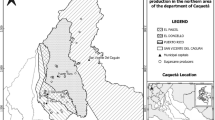Abstract
Lianas and Livelihoods: The Role of Fibrous Forest Plants in Food Security and Society around Bwindi Impenetrable National Park, Uganda This paper documents the role that fibrous plants play in rural economies of farming communities in southwestern Uganda. Thirty-five plant species from 20 plant families are used to weave baskets, stretchers, granaries, and protective coverings for clay pots. These products play a crucial role in local culture, the local economy, and social institutions as well as in food security due to their use in carrying, processing, or storing crops. Lianas (Loeseneriella apocynoides, Smilax anceps, and to a lesser extent, Cyphostemma bambuseti, Flabellaria paniculata, Hippocratea odongensis, Salacia elegans, and Urera hypselodendron) are the most important plant life-forms used, followed by bamboo (Sinarundinaria alpina). The extent of use of plant species for granaries varied significantly with altitude, vegetation type, and land-cover across the wide altitudinal range of the study area (1,440–2,600 m asl). Granaries used by farmers at lower altitudes used a higher diversity of species compared to those at a higher altitude, where 82% of granaries were constructed from bamboo (Sinarundinaria alpina). Tightly woven, durable granaries are important for food storage and therefore to the food security and sustainable livelihoods of subsistence farmers. Where length, strength, and durability of weaving fibers were required, such as for stretchers (engozi) used as local “ambulances,” only two liana species were favored. The most commonly used species was the forest liana Loeseneriella apocynoides (Celastraceae), used for up to 77% of engozi stretchers and 83% of tea-picking baskets. While most species are abundant and can be sustainably harvested, L. apocynoides is overexploited, posing problems for local people and the national park.






Similar content being viewed by others
Literature Cited
Agnew, A. D. Q. 1985. Cyclic Sequences of Vegetation in the Plant Communities of the Aberdare Mountains, Kenya. Journal of the East Africa Natural History Society and National Museum 75:1–12.
Bitariho, R. and A. McNeilage. 2007. Population Structure of Montane Bamboo and Causes of Its Decline in Echuya Central Forest Reserve, South West Uganda. African Journal of Ecology 46:325–332.
———, ———, D. Babaasa, and R. Barigyira. 2006. Plant Harvest Impacts and Sustainability in Bwindi Impenetrable National Park, S.W. Uganda. African Journal of Ecology 44:14–21.
Boko, M., I. Niang, A. Nyong, and C. Vogel. 2007. IPCC WGII Fourth Assessment Report. Chapter 9: Africa. Final Draft for Government Review, IPCC.
Bongers, F., S. A. Schnitzer, and D. Traore. 2002. The Importance of Lianas and Consequences for Forest Management in West Africa. Bioterre: Revue Internationale Scientifique de la Vie et de la Terre, Special Issue, 59–70.
Cunningham, A. B. 1996. People, Parks and Plant Use. Research and Recommendations for Multiple Use Zones and Development of Alternatives around Bwindi Impenetrable National Park, Uganda. People and Plants Working Paper 6, UNESCO, Paris.
——— and M. E. Terry. 2006. African Basketry: Grassroots Art from Southern Africa. Fernwood Press, Cape Town.
Gao, J. M., W. J. Wu, J. W. Zhang, and Y. Konishi. 2007. The Dihydro-Beta-Agarofuran Sesquiterpenoids. Natural Products Reports 24:1153–1189.
Howard, P. C. 1991. Nature Conservation in Uganda’s Tropical Forest Reserves. The IUCN Forest Conservation Programme.
Itto, A. and L. Wongo. 2002. Post-Harvest Grain Losses in On-Farm and Cooperative Stores: A Case Study of Maridi and Yambio Counties, Western Equatoria, Southern Sudan. Contract Number AOT-R-00-95-0085-00. USAID/Office of Foreign Disaster Assistance, Washington, D.C.
Muhwezi, O. 1997. The Biology and Use of Loeseneriella appocynoides around Bwindi Impenetrable National Park, Uganda. M.Sc. thesis, unpublished. Makerere University, Kampala, Uganda.
Ndangalasi, H. J., R. Bitariho, and D. B. K. Dovie. 2007. Harvesting of Non-timber Forest Products and Implications for Conservation in Two Montane Forests of East Africa. Biological Conservation 134:242–250.
Olson, D. M. and E. Dinerstein. 1998. The Global 2000: A Representation Approach to Conserving the Earth’s Most Biologically Valuable Ecoregions. Conservation Biology 12(3):502–515.
Olupot, W., R. Barigyira, and A. MacNeilage. 2009. Edge-Related Variation in Medicinal and Other “Useful” Wild Plants of Bwindi Impenetrable National Park, Uganda. Conservation Biology 23:1138–1145.
Pinedo-Vasquez, M., D. Zarin, P. Jipp, and J. Chota-Inuma. 1990. Use Values of Tree Species in a Communal Forest Reserve in Northeast Peru. Conservation Biology 4:405–416.
Plumptre, A. J. 1996. Changes Following 60 Years of Selective Timber Harvesting in the Budongo Forest Reserve, Uganda. Forest Ecology and Management 89:101–113.
———, M. Behangana, E. Ndomba, T. Davenport, C. Kahindo, R. Kityo, P. Ssegawa, G. Eilu, D. Nkuutu, and I. Owiunji. 2003. The Biodiversity of the Albertine Rift. Albertine Rift Technical Reports No. 3
Wild, R. and J. Mutebi. 1996. Conservation through Community Use of Plant Resources: Establishing Collaborative Management in Bwindi Impenetrable and Mgahiga National Park Uganda. People and Plants Working Paper 5, UNESCO, Paris.
Acknowledgments
We are greatly indebted to the WWF-UNESCO-Kew People and Plants Initiative for funding the initial field work that has led to the production of this paper, and to the Government of Uganda for additional financial support to one of us (Onesimus Muhwezi) during the research and more recent phase of updating this study. The staffs of the Institute of Tropical Forest Conservation (ITFC), CARE-Uganda office in Kabale, and Kayonza Tea Factory are also thanked for their assistance. In particular, we would like to thank Mayoba Godfrey, Owoyesingyire Narcis, Twebaze Leo, and Ngambeneza Caleb for their help during fieldwork. Michelle Cunningham is thanked for preparing the graphs as are Robert Voeks and three anonymous reviewers for their comments.
Author information
Authors and Affiliations
Corresponding author
Rights and permissions
About this article
Cite this article
Muhwezi, O., Cunningham, A.B. & Bukenya-Ziraba, R. Lianas and Livelihoods: The Role of Fibrous Forest Plants in Food Security and Society around Bwindi Impenetrable National Park, Uganda. Econ Bot 63, 340–352 (2009). https://doi.org/10.1007/s12231-009-9096-1
Received:
Accepted:
Published:
Issue Date:
DOI: https://doi.org/10.1007/s12231-009-9096-1




